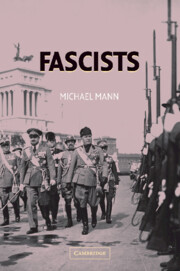Book contents
- Frontmatter
- Contents
- Preface
- 1 A Sociology of Fascist Movements
- 2 Explaining the Rise of Interwar Authoritarianism and Fascism
- 3 Italy: Pristine Fascists
- 4 Nazis
- 5 German Sympathizers
- 6 Austro-Fascists, Austrian Nazis
- 7 The Hungarian Family of Authoritarians
- 8 The Romanian Family of Authoritarians
- 9 The Spanish Family of Authoritarians
- 10 Conclusion: Fascists, Dead and Alive
- Appendix
- Notes
- Bibliography
- Index
9 - The Spanish Family of Authoritarians
Published online by Cambridge University Press: 05 June 2012
- Frontmatter
- Contents
- Preface
- 1 A Sociology of Fascist Movements
- 2 Explaining the Rise of Interwar Authoritarianism and Fascism
- 3 Italy: Pristine Fascists
- 4 Nazis
- 5 German Sympathizers
- 6 Austro-Fascists, Austrian Nazis
- 7 The Hungarian Family of Authoritarians
- 8 The Romanian Family of Authoritarians
- 9 The Spanish Family of Authoritarians
- 10 Conclusion: Fascists, Dead and Alive
- Appendix
- Notes
- Bibliography
- Index
Summary
Spain differed from the countries discussed above, though not from some of the other countries of the center, east, and south of Europe. The whole family of Spanish authoritarians – semi-authoritarians, semi-reactionaries, corporatists, and fascists – stood united against democrats and leftists. But uniquely in Europe the latter did not cave in but stood and fought. Their bloody three-year civil war ended in massive political (rather than ethnic) cleansing by the victors and then in the longest-lived rightist authoritarian regime in Europe, enduring until General Franco died in his bed in 1975. Thus Spain saw a broader-based and longer-lived authoritarianism, coming to power after both authoritarians and democrats had chosen sides, not only in elections, but also on the battlefield. As a result, we perceive certain things more clearly in Spain.
From the 1880s until 1923 Spain had been “semi-authoritarian,” as defined in Chapter 2, with both parliamentary and executive autonomous powers coexisting side by side. There were elections under a restricted franchise but the king could remove ministers, initiate legislation, and declare martial law. Despite its multiethnicity, the country was also highly centralized. The system of el turno pacifico (“peaceful change”) gave the monarch distinctive powers to alternate Conservative and Liberal ministries at will. When he decided on a change, the local political bosses (the caciques) were told that executive patronage would shift to the opposition.
- Type
- Chapter
- Information
- Fascists , pp. 297 - 352Publisher: Cambridge University PressPrint publication year: 2004



